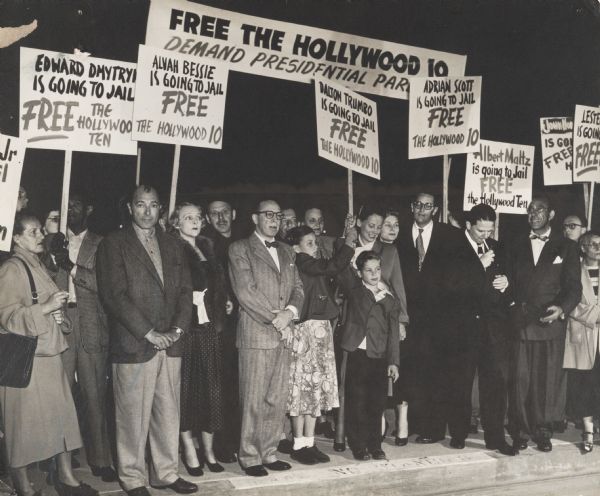
Between the late 1940s and the early 1960s, amid the postwar fears of Soviet Communist influence in the US, the Hollywood Blacklist kept hundreds of writers, directors, producers, actors, and musicians out of work in the entertainment industry due to suspicions of Communist associations or sympathies. The systematic enforcement of the Blacklist began when the group of artists that became known as the Hollywood Ten refused to cooperate with the hearings held by the House Un-American Activities Committee in 1947, and were subsequently imprisoned, and then fired by the Hollywood film studios. The Blacklist grew further through the 1950s. Red Channels named a long list of entertainment professionals accused of subversive politics. Further hearings were held by HUAC and Senator McCarran’s Internal Security Committee.
The WCFTR holds one of the most extensive sets of collections related to the Hollywood Blacklist available anywhere. The Hollywood Blacklist collections at the WCFTR include correspondence among the Hollywood Ten and other blacklistees, legal documents and case files from HUAC hearings and Blacklist litigation, and drafts and working files from the productions under suspicion. From among all of these, the collections of Dalton Trumbo and Millard Lampell are featured in this online exhibition through primary document research. The Dalton Trumbo papers include correspondence, research and drafts of writings, and legal and financial records. Trumbo is probably the most famous of the blacklistees and his papers have been explored at length by many historians. This online exhibition highlights both some of that scholarly work and the collection’s primary documents. The Millard Lampell papers include correspondence, writing drafts, clippings, and recordings. Lampell, while a significant figure in many ways, has garnered far less attention. This online exhibit, then, represents some of the first scholarly research done on Lampell. Overall, the Hollywood Blacklist collections provide deep insight into the professional and personal lives of the individuals involved in this important moment in American political and cultural history.
To see additional WCFTR collections dealing with the Blacklist, please see the Other Collections and Further Reading page.
This featured collection was researched and written by UW-Madison doctoral candidate and 2010 Jarchow fellow Danny Kimball. Thanks to Stephen Jarchow, Michele Hilmes, Vance Kepley, Maxine Ducey, Dorinda Hartmann, Liz Ellcessor, Michael Trevis and the archivists and staff at the Wisconsin Historical Society.
